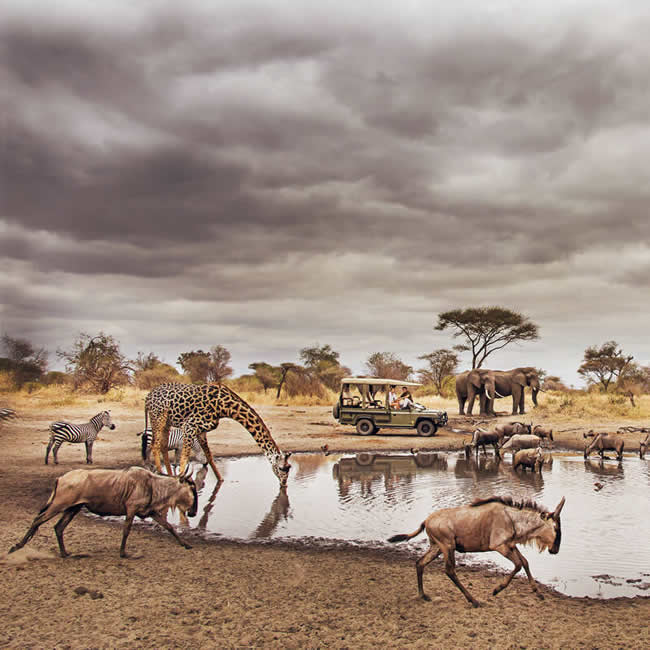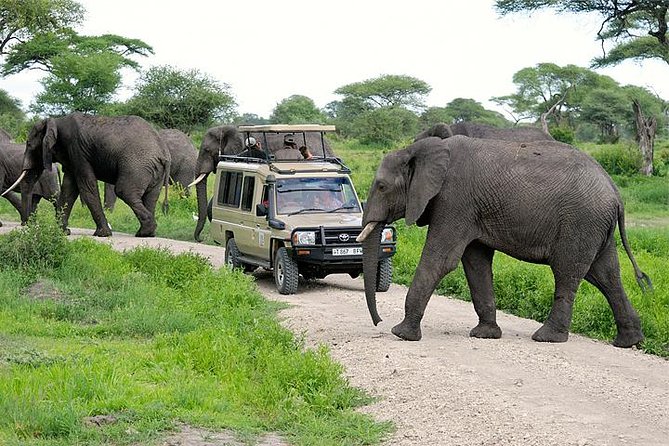...
Tarangire National Park
 Tarangire National Park is Tanzania's sixth biggest National Park covering about 2850km2 with the greatest concentration of Elephant herds over 300 individuals in the whole of Tanzania. Tarangire is home to a number of wildlife seeking refuge yearly after consistent migrations from their original habitat parks such as the Maasai Mara National Park among others. Tarangire National park is so amusing and a treasure to Tanzania as it has the Baobab trees, sausage trees and acacia trees which act as an alternative source of water to the animals.
Tarangire National Park is Tanzania's sixth biggest National Park covering about 2850km2 with the greatest concentration of Elephant herds over 300 individuals in the whole of Tanzania. Tarangire is home to a number of wildlife seeking refuge yearly after consistent migrations from their original habitat parks such as the Maasai Mara National Park among others. Tarangire National park is so amusing and a treasure to Tanzania as it has the Baobab trees, sausage trees and acacia trees which act as an alternative source of water to the animals.
Tarangire National Park was first established in 1957 by the British colonial government in Tanzania as a game reserve who named it after River Tarangire "meaning the river of warthogs" which crosses the reserve in the mid-way serving as the major source of water in the area. as a reserve, Tarangire was created with a major aim of conserving wildlife in the region which had been left roaming after the dry season and this gave them need to designate the land as a national park which was fulfilled in 1970. Over 2850km2 of land was gazetted, situated south of Lake Manyara National Park in Manyara Region.
The park is located in Northern Tanzania and is 75miles south western part of Arusha region, it is made up of Tarangire river, large marshes that feed off many tributaries of river Tarangire, however these tributaries are usually dry during the dry season and only flow in the wet season all contributing to the ever green mixed acacia and elephant grass of the national park.
Attractions
Tarangire National Park is home to diverse ecological existence of the flora and wildlife of the Manyara region where the park is found among which are the big 5 animals of Africa that is the Elephants, lions, leopards, buffaloes and Rhinos yet this park is the most seasonal park in Tanzania having animals Migrate time to time.
Wildlife
Tarangire National Park is home to various among which is the largest concertation of Elephants, about 300 individuals that can easily be seen enjoying the savannah grasslands of the park. The park has very much special wildlife such as the tree climbing lions that are come to the Ishasha Sector of Queen Elizabeth National park in Uganda, but to Tanzania, they can be found in Tarangire National park. Other animals include the Zebras, leopards, Buffaloes, wildebeests, elands, rhinos, hartebeests, long necked gerenuk, fringe earned Oryx among others that are best viewed in the morning during the nature walks or game drives and in the dry season when they all migrate to River Tarangire.
Birds
Tarangire national park is home to over 500 bird species that survive in the woodlands and the savannah grasslands. These species have varying colors and sizes such as yellow necked purfow, francolins, hoopoes, hornbills, guinea fowl, steppe eagles, faced vulture, white-bellied go away bird, bee eaters, Lilac breasted rollers, swifts, hammerkops, striped swallows and many more that are interesting for birders to watch.
The giant Baobab Tree
These are very ancient trees that ancestors believed could move any recklessly from one place to another which annoyed God and He made them turn upside down to stop them from roaming every where. The Baobab trees are also known as "the tree of life" since they can store up to 300 to 900 liters of water in their trunk which is later used by the wildlife during the dry season. These trees have the longest life span of over six hundred years that make them prevalent from all other plantation. The Baobab tree trunks are so rough that Elephants use them to sharpen their huge tusks.
Swamps
Due to the presence of River Tarangire and the large marshes, Tarangire National Park is made of a network of swamps that act as a habitat to various wildlife most especially in the southern and the Eastern part of the Park. These swamps habit tree climbing pythons, silale warms, lions, African wild dogs, cape buffaloes among other wildlife and birds including, white faced whistling-duck, northern white-crowned, and many more ravishing in the park.
Tarangire River
This is the major source of water in the park, feeding all the wildlife in it and most especially in the dry season when all animal anchor by the river sides. River Tarangire crosses Tarangire National Park making it the parks Iconic tourist attraction and back ground of the park name making it internationally recognized. This river hosts meetings of animals such as the Elephants, buffaloes, zebras, antelopes, wildebeests plus others in need of water.
Activities
being home of the great Baobab tree and the largest concentration of Elephants along with over 500 bird species, Tarangire national park has plenty of tourist activities that include;
Game drives
Tarangire National park mainly has two game drives that are done in the morning and in the evening depending on the tourist's preference, however, the morning game drive is the best permitting you to view animals come out to hunt for food early in the morning in the savannah grasslands of the park. while on any game drive in Tarangire National park, stand assured of animals like the Elephants, Elands, buffaloes, antelopes, zebras, water bucks and so many and these are best seen when the drive heads to river Tarangire where animals gather for water most especially in the dry season.
Guided Nature walks
Guided nature walks in Tarangire national park offer the closest view range of animals in the park under the supervision of the well trained and experienced park guides and rangers that offer security to both the tourist and the animals. During the guided nature walk, different trails can be used to pass through the savannah grasslands as tourists get to encounter diverse plantations among which is the Baobab tree or tree of life.
Birding / bird watching
Tarangire National park is home to over 500 bird species habiting the woodlands, swamps and the savannah grasslands. Among these are Ashy starlings, hornbills, ostriches, parrots, yellow collared love birds, hammerkops, yellow necked purfow, francolins, hoopoes, hornbills, guinea fowl, steppe eagles, faced vulture, white-bellied go away bird, bee eaters, Lilac breasted rollers and many more that bird watchers explore while on this activity.
Community visit
Tarangire national park is where the Maasai originally settled in Tanzania and the Barbaig. The two communities are a great tourist attraction with great history which is impressing to listen to. These as well have good art and craft, local dances, food the share as tourists are on the community visit to their side. Chances also given to those that wish to visit the local markets and make shopping if they wish to.
When is the best time to visit Tarangire National park?
Tarangire National Park is a home away from home that welcomes visitors at any time of the yea. However, it is best to be visited during the dry season when the savannah grasslands are permeable and short offering the best view of the wildlife in the park. The dry months run from June to October when the animals reside by the river sides of River Tarangire since it is the only place in the area where water can be found. The months from January to March are the middle range season where both dry and wet is experienced making it also very good for tourists to explore Tarangire National Park since the grasslands are ever green then and all animals have great moments feeding all time.
Top Tanzania Destinations
BOOK OUR CURATED SAFARIS
Add Uganda and Rwanda to your travel list this year as we are offering a fantastic tailor-made tours to individual and small groups



